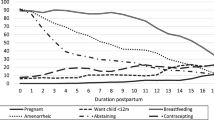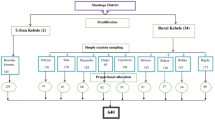Abstract
If used properly, the lactational amenorrhea method (LAM) can be a valuable family planning tool, particularly in low-income countries; however, the degree to which LAM is used correctly and characteristics associated with its use have not been well documented. We therefore sought to use nationally representative data from Niger, where fertility rates are high and women may have limited access to alternative contraceptive methods, to describe the proportion of women who use LAM correctly and the characteristics associated with LAM use. We utilized cross-sectional data from the 2006 Niger Demographic Health Survey. Our sample included all sexually active, non-pregnant, breastfeeding women using some form of contraception (N = 673, unweighted). We used weighted frequencies to describe the correct use of LAM and logistic regression models to describe women who chose LAM for contraception. Among our sample, 52 % reported LAM as their primary method of contraception, but only 21 % of the women who reported using LAM used it correctly. Women who reported using LAM were more likely to live in certain regions of the country, to have no formal education, and to have delivered their most recent baby at home. They were also less likely to have discussed family planning at a health facility or with their husband/partner in the past year. Results indicated that few women in Niger who reported using LAM used it correctly. Our findings reinforce the need to address this knowledge gap, especially given Niger’s high fertility rate, and may inform efforts to improve family planning in Niger and in other low-income countries.
Similar content being viewed by others
References
Gipson, J. D., Koenig, M. A., & Hindin, M. J. (2008). Effects of unintended pregnancy on infant, child, and parental health: A review of the literature. Studies in Family Planning, 39, 18–38.
Sedgh, G., et al. (2007). Women with an unmet need for contraception in developing countries and their reasons for not using a method. New York: Guttmacher Institute. Available: http://www.guttmacher.org/pubs/2007/07/09/or37.pdf.
(1988). Consensus statement: Breastfeeding as a family planning method. Lancet, 2, 1204–1205.
Kennedy, K. I., Rivera, R., & McNeilly, A. S. (1989). Consensus statement on the use of breastfeeding as a family planning method. Contraception, 39, 477–496.
(1996). Consensus statement: Lactational amenorrhea method for family planning. The Journal of Midwifery & Women’s Health, 41, 405–406.
Perez, A., Labbok, M. L., & Queenan, J. T. (1992). Clinical study of the lactational amenorrhea method for family planning. Lancet, 339, 968–970.
Institute of Medicine. (1991). Nutrition during lactation. Washington, DC: National Academy Press.
Dewey, K. G., et al. (1997). Effects of age at introduction of complementary foods to breast-fed infants on duration of lactational amenorrhea in Honduran women. The American Journal of Clinical Nutrition, 65, 1403–1409.
Labbok, M., Cooney, K., & Coly, S. (1994). Guidelines: Breastfeeding, family planning, and the lactational amenorrhea method-LAM. Washington, DC: Institute for Reproductive Health.
Shaaban, O. M., & Glasier, A. F. (2008). Pregnancy during breastfeeding in rural Egypt. Contraception, 77, 350–354.
Peterson, A. E., et al. (2000). Multicenter study of the lactational amenorrhea method (LAM) III: Effectiveness, duration, and satisfaction with reduced client-provider contact. Contraception, 62, 221–230.
Kazi, A., et al. (1995). Effectiveness of the lactational amenorrhea method in Pakistan. Fertility and Sterility, 64, 717–723.
World Health Organization Task Force on Methods for the Natural Regulation of Fertility. (1999). The World Health Organization multinational study of breast-feeding and lactational amenorrhea III. Pregnancy during breast-feeding. Fertility and Sterility, 72, 431–440.
Turk, R., Terzioglu, F., & Eroglu, K. (2010). The use of lactational amenorrhea as a method of family planning in eastern Turkey and influential factors. Journal of Midwifery and Women’s Health, 55, e1–e7.
Romero-Gutierrez, G., et al. (2007). Actual use of the lactational amenorrhoea method. The European Journal of Contraception and Reproductive Health Care, 12, 340–344.
Potts, M., Gidi, M., & Zureick, S. (2011). Niger: Too little, too late. International Perspectives on Sexual and Reproductive Health, 37, 95–101.
Institut National de la Statistique (INS) and Macro International Inc. (2007). Enquête Démographique et de Santé et à Indicateurs Multiples du Niger 2006. Calverton, Maryland, USA: INS and Macro International Inc. Available: http://www.measuredhs.com/aboutsurveys/search/metadata.cfm?surv_id=277&ctry_id=29&SrvyTp=available.
Population Reference Bureau. (2011). Niger summary. Available: www.prb.org/datafinder/geography/summary.aspx?region=28®ion_type=2.
MEASURE DHS. (2004). DHS comparative reports 6: The DHS wealth index. Calverton, MD: MEASURE DHS+. Available: http://www.childinfo.org/files/DHS_Wealth_Index_(DHS_Comparative_Reports).pdf.
Labbok, M. H., et al. (1997). Multicenter study of the lactational amenorrhea method (LAM): I. Efficacy, duration, and implications for clinical application. Contraception, 55, 327–336.
Cooney, K. A., et al. (1996). An assessment of the nine-month lactational amenorrhea method (MAMA-9) in Rwanda. Studies in Family Planning, 27, 162–171.
Short, R. V., et al. (1991). Contraceptive effects of extended lactational amenorrhea: Beyond the Bellagio Consensus. Lancet, 337, 715–717.
Kennedy, K. I., & Visness, C. M. (1992). Contraceptive efficacy of lactational amenorrhoea. Lancet, 339, 227–230.
Kost, K., et al. (2008). Estimates of contraceptive failure from the 2002 National Survey of Family Growth. Contraception, 77, 10–21.
Author information
Authors and Affiliations
Corresponding author
Rights and permissions
About this article
Cite this article
Sipsma, H.L., Bradley, E.H. & Chen, P.G. Lactational Amenorrhea Method as a Contraceptive Strategy in Niger. Matern Child Health J 17, 654–660 (2013). https://doi.org/10.1007/s10995-012-1054-3
Published:
Issue Date:
DOI: https://doi.org/10.1007/s10995-012-1054-3




